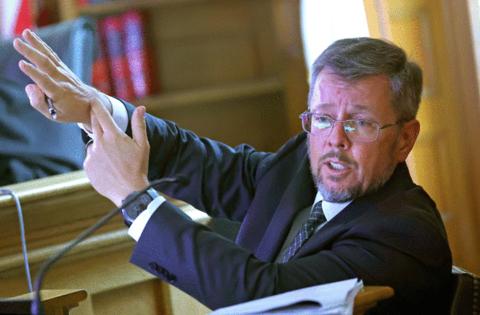Crash reconstructionist doubles down on vehicle strike in Karen Read retrial
Published in News & Features
DEDHAM, Mass. — A crash reconstructionist reiterated his belief that John O’Keefe died by a vehicle strike during his second day of testimony in the Karen Read retrial.
“It is consistent with being struck by a Lexus and ultimately contacting a hard surface like frozen ground,” Judson Welcher, a PhD in biomedical engineering who serves as an executive vice president at the forensic consulting firm Aperture LLC, said of the injuries O’Keefe suffered on Jan. 29, 2022.
Read, 45, of Mansfield, faces charges of second-degree murder, manslaughter while operating a motor vehicle under the influence, and leaving the scene of a collision causing death.
Welcher’s testimony during direct examination on Wednesday largely reiterated the conclusions he reached at the end of the previous day after he walked jurors through hours of spreadsheet data from Read’s Lexus LX570 SUV — the alleged murder weapon — and O’Keefe’s cell phone.
He also detailed his physical testing, which included dressing up like O’Keefe, who was roughly Welcher’s size, and having an identical vehicle hit him at low speed to see where the taillight may hit his arm.
The reason he reiterated his conclusions is that on Tuesday this assertion that “within a reasonable degree of scientific certainty” such a vehicle strike “is what happened,”drew an objection from defense attorney Robert Alessi. Alessi argued after the jurors were dismissed that such a conclusion should be only for the jury. Judge Beverly J. Cannone sat on the issue overnight and then issued her ruling on what Welcher could testify ahead of trial Wednesday morning.
“Dr. Welcher can testify that the data he downloaded and analyzed and the damage to the Lexus is consistent with Ms. Read’s vehicle being in a collision on Jan. 29 at 12:32 a.m. because he’s a qualified expert and his opinion is based on reliable methodology appropriately applied,” Cannone said. She added he could also conclude that O’Keefe’s injuries are consistent with such a strike because the “opinion is based upon … his experimental work that came into evidence without objection as to scientific methodology and application.”
But, she said, Welcher could not testify that Read’s Lexus actually collided with O’Keefe because “that conclusion is not based on the application of reliable scientific methodology.”
Welcher also testified that it is “not uncommon” to see vehicle-pedestrian strikes without broken bones in the lower body, which built on his testimony Tuesday that head wounds were the number one injury seen after vehicle strikes.
Cross examination
Most of Wednesday, however, was given to Alessi’s cross-examination of Welcher, who Read herself hinted could be the prosecution’s final witness. Attorneys are under gag orders in this case and the prosecution generally refrains from speaking outside of the courtroom anyway so there is no way to confirm with prosecutor Hank Brennan if this is his final witness.
The cross emphasized limitations to Welcher’s methodology and knowledge and the scope of his testing.
For one, Alessi asked if Welcher was aware that the study he cited regarding head wounds being the number one injury occurred in vehicle strikes was from the 1970s and if he would be surprised to learn that current research says that the most common injury is to lower extremities.
“It wouldn’t surprise me,” Welcher said.
The cross also involved much discussion of Newtonian physics and what forces a huge vehicle like the LX570 would have on the bones of O’Keefe’s body, especially the force needed to break the bones in O’Keefe’s hand. The physics got intense enough that Welcher at one point asked permission to use a calculator to solve a formula prompt from Alessi.
And it was at this point where the cross became a relatively tense exchange, with Welcher frequently responding that there wasn’t enough information available to answer Alessi’s specific questions and that “anything’s possible.”
In one example, Alessi asked if the vehicle would have ended up on the lawn during the course of backing up at least 87 feet, which Welcher testified on Tuesday. Welcher said that he would need to have known where precisely the vehicle was when it began its backup to answer that question.
“Your first question was ‘reasonable.’ And I said no. Now you’re asking ‘possible.’ Of course it is possible,” Welcher said. “… I would need more information to be able to determine whether it’s reasonable or not. It’s certainly possible. It’s possible it could have shot into space, but not probable.”
Alessi seemed taken aback by the answer and asked, “It’s a possibility this Lexus could have been shot into space, sir?”
“Highly, highly unlikely,” Welcher said. “But, again, you’re asking an engineer about possibilities and probabilities.”
But outside the specific physics questions, Alessi also criticized that Welcher’s reconstruction didn’t include the possibility that O’Keefe could have been standing on the berm at the edge of the road, which Welcher estimated was four inches tall, or that he was on the lawn and the vehicle hit him while elevated by the berm.
Alessi also highlighted that Welcher had amended his report after the trial began — leaving the defense little room for a robust rebuttal of the material — and brought up that Aperture LLC will make nearly $400,000 off the case, for the time of the company’s experts and their analysis and testing.
As for the Lexus Welcher used in his testing, Welcher said his company purchased the vehicle and will keep it until the end of trial and then sell it. The Norfolk District Attorney’s Office will pay for the difference between purchase and sales price.
“We’re an engineering company,” Welcher said. “We bill for our time.”
_______
©2025 MediaNews Group, Inc. Visit at bostonherald.com. Distributed by Tribune Content Agency, LLC.







Comments